1994 OLDSMOBILE SILHOUETTE oil
[x] Cancel search: oilPage 12 of 276

How to Use this Manual
These symbols are on some of your
controls:
Windshield Wipers
Windshield Washer
w
Windshield Defroster
Rear Window Defogger
Rear Window Wiper
Rear Window Washer Ventilating Fan
Power Window
10
3f
These symbols are used on warning
and indicator lights:
Engine Coolant Temperature
Battery Charging
System
Fuel
Engine
Oil Pressure
Brake
AntXock Brakes
p3
Here are some other symbols you
may see:
Fuse
Lighter
Horn
Speaker
Hood Release
ProCarManuals.com
Page 63 of 276
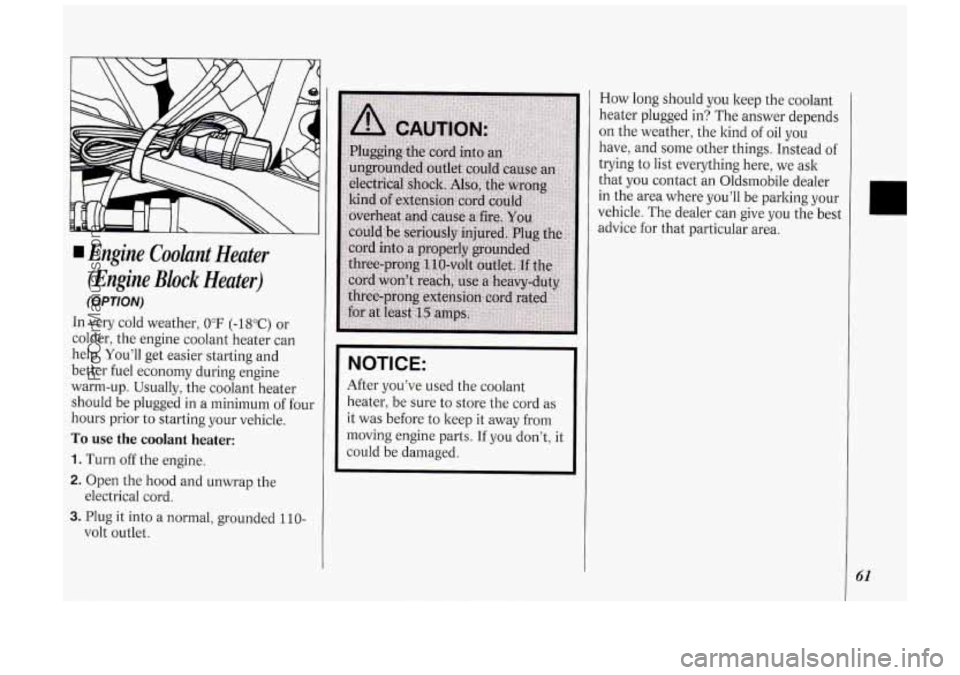
Engine Cooknt Heater
(Engine
Block Heater)
(OPTION)
In very cold weather, 0°F (-18°C) or
colder, the engine coolant heater can
help. You’ll get easier starting and
better fuel economy during engine
warm-up. Usually, the coolant heater
should be plugged in a minimum of four
hours prior to starting your vehicle.
To use the coolant heater:
1. Turn off the engine.
2. Open the hood and unwrap the
3. Plug it into a normal, grounded 110-
electrical cord.
volt outlet.
NOTICE:
After you’ve used the coolant
heater, be sure to store the cord as
it was before to keep it away from
moving engine parts. If you don’t, it
could be damaged. How
long should you keep the coolant
heater plugged in? The answer depends
on the weather, the kind
of oil you
have, and some other things. Instead
of
trying to list everything here, we ask
that
you contact an Oldsrnobile dealer
in the area where you’ll be parking your
vehicle. The dealer can give you the best
advice for that particular area.
41
ProCarManuals.com
Page 103 of 276
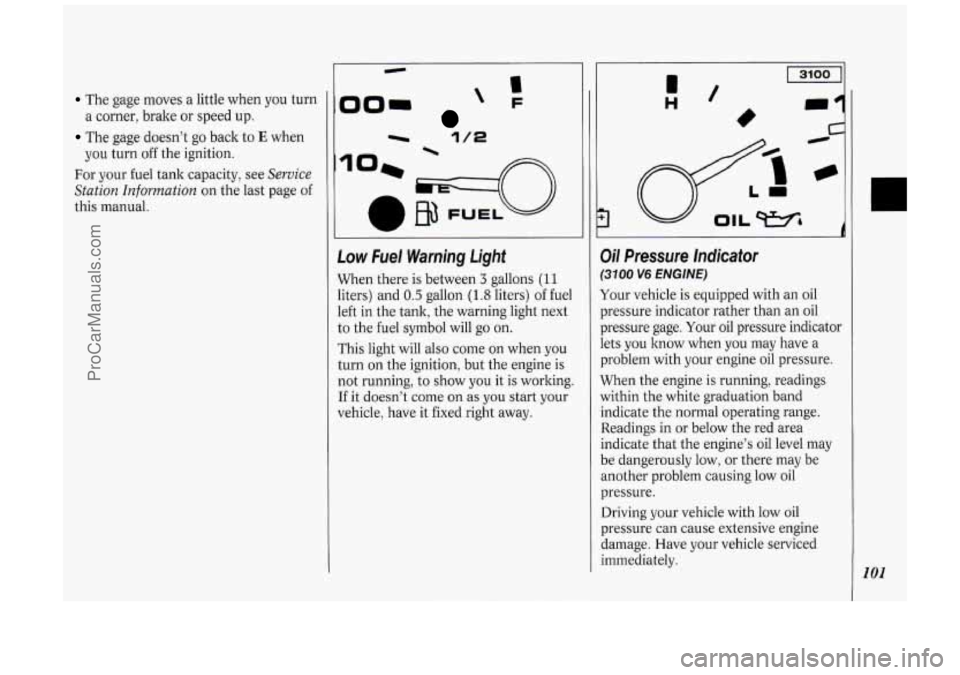
The gage moves a little when you turn
The gage doesn’t go back to E when
For your fuel tank capacity, see
Service
Station Information
on the last page of
this manual. a corner, brake or
speed
up.
you turn off the ignition.
_____ 0
‘F
I
00-
- 1/2
Low Fuel Warning Light
When there is between 3 gallons (1 1
liters) and 0.5 gallon (1.8 liters) of fuel
left in the tank, the warning light next
to the fuel symbol will go on.
This light will also come on when you
turn on the ignition, but the engine is
not running, to show you it is working.
If it doesn’t come on as you start your
vehicle, have it fixed right away.
d
Oil Pressure lndicator
(31 00 V6 ENGINE)
Your vehicle is equipped with an oil
pressure indicator rather than an oil
pressure gage. Your oil pressure indicator
lets
you know when you may have a
problem with your engine oil pressure.
When the engine is running, readings
within the white graduation band
indicate the normal operating range.
Readings in or below the red area
indicate that the engine’s oil level may
be dangerously low, or there may be
another problem causing low oil
pressure.
Driving your vehicle with low oil
pressure can cause extensive engine
damage. Have your vehicle serviced
immediately.
101
ProCarManuals.com
Page 104 of 276
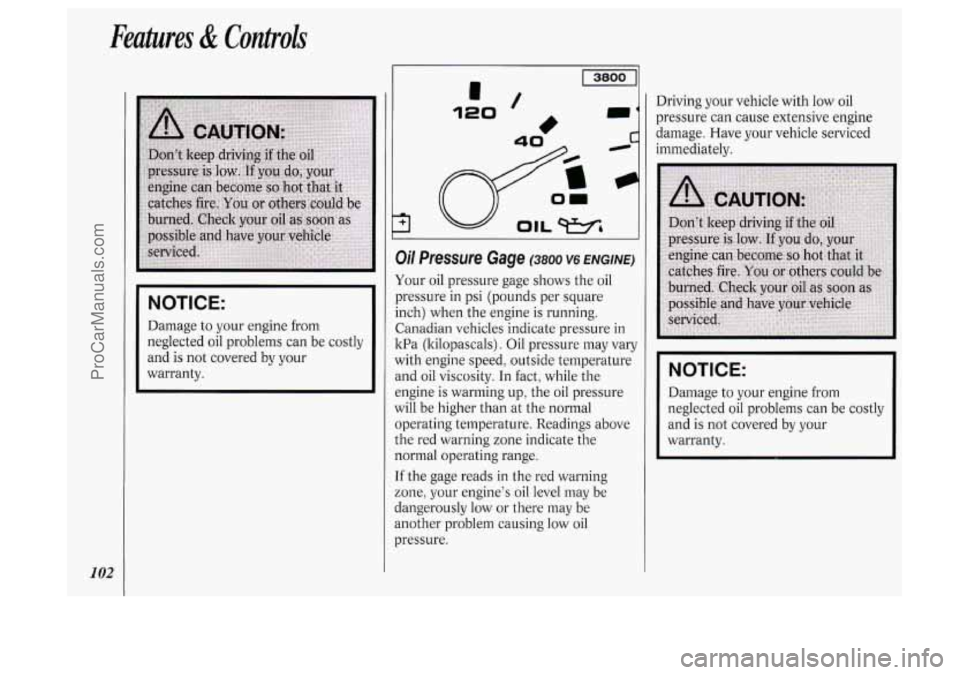
Features & Controls
102
NOTICE:
Damage to your engine from
neglected oil problems can be costly
and
is not covered by your
warranty.
I I
3il Pressure Gage (3800 v6 ENGINE)
four oil pressure gage shows the oil
x-essure
in psi (pounds per square
nch) when the engine is running.
Zanadian vehicles indicate pressure in
vith engine speed, outside temperature
md oil viscosity. In fact, while the
mgine is warming up, the oil pressure
vi11 be higher than at the normal
Iperating temperature. Readings above
.he red warning zone indicate the
lormal operating range.
.f the gage reads in the red warning
:one, your engine's oil level may be
langerously low or there may be
mother problem causing low oil
xessure. Driving
your vehicle with low oil
pressure can cause extensive engine
damage. Have your vehicle serviced
immediately.
NOTICE:
Damage to your engine from
neglected oil problems can be costly
and is not covered by your
warranty.
ProCarManuals.com
Page 131 of 276
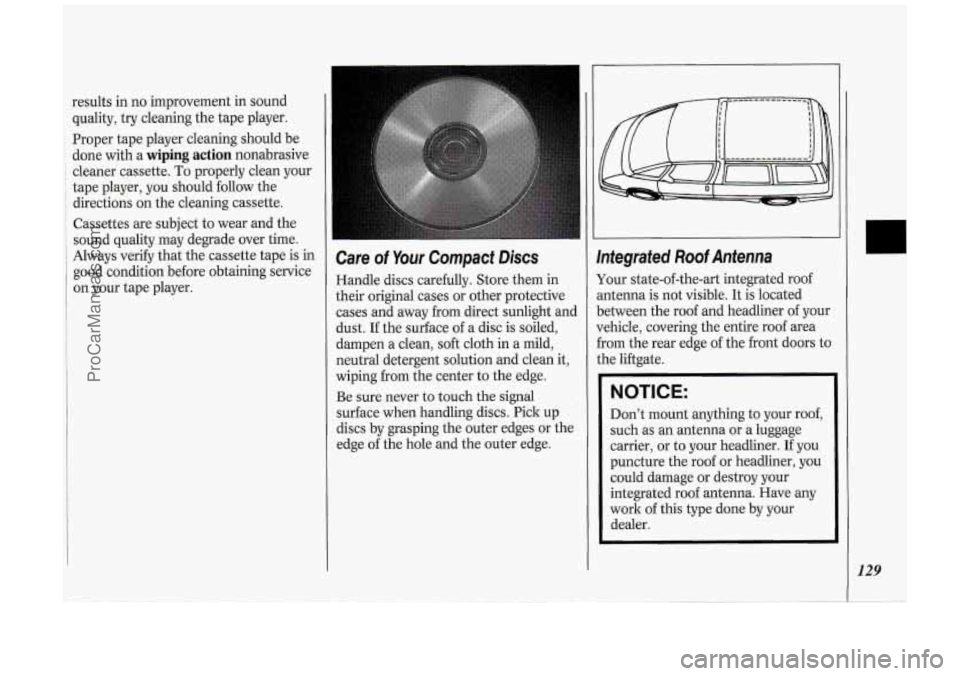
results in no improvement in sound
quality,
try cleaning the tape player.
Proper tape player cleaning should be
done with a
wiping action nonabrasive
cleaner cassette. To properly clean your
; tape player, you should follow the
I
directions on the cleaning cassette.
Cassettes are subject to wear and the
1 sound quality may degrade over time.
Always verlfy that the cassette tape is in
good condition before obtaining service
on your tape player.
:are of Your Compact Discs
Handle discs carefully. Store them in
their original cases or other protective
cases and away from direct sunlight and
dust. If the surface of a disc is soiled,
dampen a clean, soft cloth in a mild,
neutral detergent solution and clean it,
wiping
from the center to the edge.
Be sure never to touch the signal
surface when handling discs. Pick up
discs by grasping the outer edges or the
edge of the hole and the outer edge.
In
YC
an
be
ve
frc
th
I
I
mtegrated Roof Antenna
)ur state-of-the-art integrated roof
ltenna is not visible. It is located
!tween the roof and headliner of your
Ihicle, covering the entire roof area
3m the rear edge
of the front doors to
.e liftgate.
NOTICE:
Don't mount anything to your roof,
such as an antenna or a luggage
carrier, or to your headliner. If you
puncture the roof or headliner, you
could damage or destroy your
integrated roof antenna. Have any
work of this type done by your
dealer.
129
ProCarManuals.com
Page 148 of 276
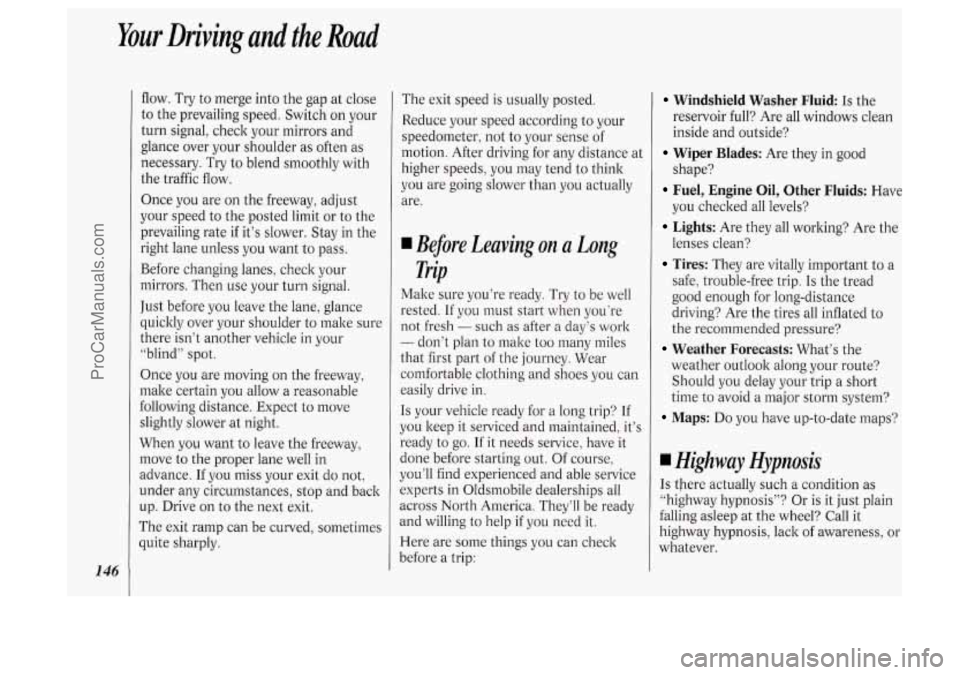
Your Driving and the Road
146
flow. Try to merge into the gap at close
to the prevailing speed. Switch on your
turn signal, check your mirrors and
glance over your shoulder as often as
necessary. Try to blend smoothly with
the traffic flow.
Once
you are on the freeway, adjust
your speed to the posted limit or to the
prevailing rate
if it’s slower. Stay in the
right lane unless you want to pass.
Before changing lanes, check your
mirrors. Then use your turn signal.
Just before you leave the lane, glance
quickly over your shoulder to make sure
there isn’t another vehicle in your
“blind” spot.
Once you are moving
on the freeway,
make certain you allow a reasonable
following distance. Expect to move
slightly slower at night.
When you want to leave the freeway,
move to the proper lane well in
advance. If you
miss your exit do not,
under any circumstances, stop and back
up. Drive on to the next exit.
The exit ramp can be curved, sometimes quite sharply. The exit
speed
is usually posted.
Reduce your speed according to your
speedometer, not to your sense of
motion. After driving for any distance at
higher speeds, you may tend to think
you are going slower than you actually
are.
I Before Leaving on a Long
Trip
Make sure you’re ready. Try to be well
rested. If you must start when you‘re
not fresh
- such as after a day’s work
- don’t plan to make too many miles
that first part of the journey. Wear
comfortable clothing and shoes you can
easily drive in.
Is your vehicle ready for a long trip? If
you keep it serviced and maintained, it’s
ready to go. If
it needs service, have it
done before starting out. Of course,
you’ll find experienced and able service
experts in Oldsmobile dealerships all
across North America. They‘ll be ready
and willing to help
if you need it.
Here are some things you can check
before a trip:
Windshield Washer Fluid: Is the
reservoir full? Are
all windows clean
inside and outside?
shape?
you checked all levels?
lenses clean?
safe, trouble-free trip.
Is the tread
good enough for long-distance
driving? Are the tires all inflated to
the recommended pressure?
weather outlook along your route?
Should you delay your trip a short
time to avoid a major storm system?
Maps: Do you have up-to-date maps?
Wiper Blades: Are they in good
Fuel, Engine Oil, Other Fluids: Have
Lights: Are they all working? Are the
Tires: They are vitally important to a
Weather Forecasts: What’s the
Highway Hypnosis
Is tbere actually such a condition as
“highway hypnosis”? Or is it just plain
falling asleep at the wheel? Call it
highway hypnosis, lack of awareness, or
whatever.
ProCarManuals.com
Page 158 of 276

Your Driving and the Road
156
Parking on Hills
You really should not park your vehicle,
with a trailer attached, on a hill. If
something goes wrong, your rig could
start to move. People can be injured,
and both your vehicle and the trailer
can be damaged.
But
if you ever have to park your rig on
a hill, here’s how to do it:
1. Apply your regular brakes, but don’t
shift into
P (Park) yet.
2. Have someone place choclts under
the trailer wheels.
3. When the wheel chocks are in place,
release the regular brakes until the
chocks absorb the load.
apply your parking brake, and then
shift to
P (Park).
4. Reapply the regular brakes. Then
5. Release the regular brakes.
When You Are Ready to Leave
Affer Parking on a Hill
1. Apply your regular brakes and hold
the pedal down while
you:
Start your engine;
Shift into a gear; and
Release the parking brake.
2. Let up on the brake pedal.
3. Drive slowly until the trailer is clear
4. Stop and have someone pick up and
of
the chocks.
store the chocks.
Maintenance When Trailer Towing
Your vehicle will need service more
often when you’re pulling a trailer. See
the Maintenance Schedule
for more on
this. Things that are especially important in
trailer operation are
automatic transaxle fluid (don’t
overfill), engine oil, belts, cooling
system, and brake adjustment. Each of
these is covered in this manual, and the
Index will help you find them quicltly. If
you’re trailering, it’s a good idea to
review these sections before you start
your trip.
Check periodically to see that all hitch
nuts and bolts are tight.
ProCarManuals.com
Page 169 of 276

Cooling System
When you decide it’s safe to lift the
hood, here’s what you’ll see:
(A) Coolant recovery tank
(B) Radiator pressure cap
(C) Electric engine fan, or fans if you
have the
3800 V6 engine.
If the coolant inside the coolant
recovery tank is boiling, don’t do
anything else until it cools down. The coolant
level should be at or above
the
FULL HOT mark. If it isn’t, you
may have a leak in the radiator hoses,
heater hoses, radiator, water pump or
somewhere else in the cooling system.
ProCarManuals.com